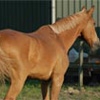|
Advice article filter
|
Horse too thin, gaining weightA lot of horses loose condition in winter. This could have been caused by, for instance, a worm infection, teeth problems, stress or pain. You have to call the vet when a horse looses weight very quickly. But more often, the cause is incorrect feeding of the horse. If you have a healthy horse, who is allowed to be a bit rounded, look first where your horse is thin, before you start adjusting the feeding.
In general there are two areas where your horse could look thin. These two areas each need a different feeding approach:
What you can do to improve the top line The top line includes the neck, shoulder, withers, ribs and the back. These are areas where it is easy for the horse to store fat. The distribution of the fat is never equal, so it is possible that the withers are thin while the neck still looks good. Loosing weight from the top line means that the horse has already used it’s reserves for some time. For a period, your horse did not get enough energy or protein in the feed. The solution you are looking for, should be the increase of the energy content of the feed. If the muscles are also reduced in volume, then you have to check the amount of protein. This is probably too low. Have a look at your roughage, like hay or haylage. If the roughage has a yellow or brown/yellow colour, then the nutritional value is on the low side. Check your roughage! Be aware that more than 60% of your horse’s feed consists of roughage. So roughage has a big influence on the condition of your horse. Pay attention and spend enough time on determining the quality of your roughage. If you really want to do a good job, have your roughage analysed. You then know exactly what you feed your horse and you are able to bring your hard feed inline with the amount of roughage. It is preferable to purchase a better quality roughage than to increase the amount of hard feed! Usually people assume that haylage has a high protein content. However, nowadays haylage has around the same nutritional value as hay (measured as dry matter), only the moisture content is different. It is a pity that a lot of people still think that haylage is rich in energy and protein and therefore give less to the horse. This is a big mistake! You have to feed more haylage than hay to your horse because haylage contains more water. Be careful when you give more hard feed! A simple way to increase the amount of energy in the feed is to give 1 to 1.5 kg more hard feed. Reduced top line, but not muscles: add Pavo Herbal Melange (muesli) orPavo EnergyControl (cubes) What can you do when the flanks of your horse are collapsed? Collapsed flanks is also called ‘tucked up’. The rounding of the stomach is mainly determined by the major guts. Here, fibres from roughage are collected. So a tucked up horse has a reduced volume in this part of the digestive tract. When you know this, it is easy to find a solution for this problem: give more roughage! In case you require comprehensive feeding advice for your horse and your situation, complete the FeedingGuide. But also: weigh the amount of roughage you give to your horse.  |

